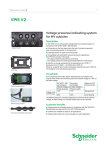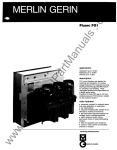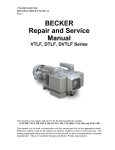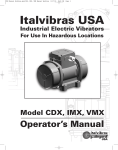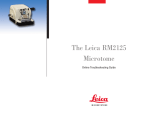Download Operating Instructions - Schneider Electric België
Transcript
Medium Voltage Distribution F400 Air insulated switchboard Withdrawable circuit breaker 1 to 40.5 kV Instruction for use September 2009 Content Note: the subject of this new version of this user guide is about the annexe “Adaptation/instructions - Replacement of the voltage presence type VPIS 1 by type VPIS 2 and VPIS 2 by VPIS 2”, updated on july 2009. General description Glossary Cable incoming or outgoing cubicles Bus coupler cubicles Bus riser cubicles Draw-out SF circuit-breakers Draw-out bar bridge Identification How to read the information on the front side Symbols List of optional accessories available with the switchboard Operating Instructions How to extract the removable part How to insert the removable part How to plug in the removable part (bottom front plate) How to draw-out the removable part (bottom front plate) How to close the MV cable earthing isolator (top front plate) How to open the MV cable earthing isolator (top front plate) How to operate the adjustable voltage transformers Padlocking Key-locking Testing “Power on” on the MV cables Checking phase coincidence between two cubicles Testing MV cables Switchboard dielectric test Testing the current transformers Busbar earthing truck Maintenance Instructions version G0 8 8 9 11 12 13 14 16 18 20 21 21 21 21 22 22 23 24 Ordering parts Preventive maintenance Maintenance points Access to top and bottom plug-in blocks Access to the voltage transformers Replacing the fuses of the adjustable voltage transformers Replacing the VT position auxiliary contacts Replacing the “power on” Led block Replacing the earthing isolator position auxiliary contacts Replacing the removable part position auxiliary contacts Trouble-shooting 24 24 24 25 27 28 29 29 30 31 32 Annexe 33 Adaptation/instructions - Replacement of the voltage presence type VPIS 1 by type VPIS 2 and VPIS 2 by VPIS 2 07897171EN.indd 2 2 2 3 4 5 5 6 6 7 7 33 General description Glossary Abbreviations Warning: all dimensions are in cm. LV: low Voltage MV:36 kV voltage class EI: earthing isolator SF: range of SF6 circuit-breakers used in the F400 VT: Voltage Transformer NVC: no-voltage check CT: Current Transformer or current sensor CT Add: second row of current transformer. Cable incoming or outgoing cubicles Front side A: LV compartment access door B: removable part compartment access door C: removable part position check view ports D: removable part interlocking and operating plate E: voltage indicators F: earthing isolator interlocking and operating plate G: removable part blocking. Left-hand view 1: LV cable routing and connection compartment 2: low voltage compartment 3: busbar compartment 4: MT and VT cable compartment 5: removable part compartment H: removable part J: earthing isolator K: earthing isolator operating mechanism L: voltage transformer. version G0 07897171EN.indd General description Bus coupler cubicles Front side A: LV compartment access door B: removable part compartment access door C: view ports D: removable part interlocking and operating plate E: removable part interlocking plate. Left-hand view 1: LV cable routing compartment 2: low voltage compartment 3: bottom busbar compartment 4: top busbar compartment 5: removable part compartment F: removable part interlocking mechanism G: removable part H: voltage transformer. 07897171EN.indd version G0 General description Bus riser cubicles Front side A: LV compartment access door B: fixed bar bridge compartment access door C: view ports. Left-hand view 1: LV cable routing compartment 2: low voltage compartment 3: bottom busbar compartment 4: top busbar compartment D: voltage transformer. version G0 07897171EN.indd General description Draw-out SF circuit-breakers SF1 CEI 1250 A standard SF2 CEI 1250 A standard SF2 CEI 2500 A standard Draw-out bar bridge 1250 A and 2500 A 07897171EN.indd version G0 General description Identification Functional unit A: cubicle name B: firm plate C: features, descriptions and serial number. SF draw-out removable part C: features, descriptions and serial number. 1: mechanical opening push-button 2: removable part position selector 3: removable part operating crank insertion aperture. A: removable part mechanical position indicator B: slot for the disconnecting truck lock (optional). How to read the information on the front side Removable part Earthing isolator, power on and plug-in disabling L1 L2 A: power-on indicator block B: earthing isolator position selector C: slot for the earthing isolator lock D: earthing isolator operating crank insertion opening E: locking pull for plug-in disabling (plug-in disabling selector) F: slot for the plug-in disabling lock. L3 5 4 O version G0 07897171EN.indd General description Symbols “Plug-in disabling” position Cubicle “Operating” position Earthing isolator open position Earthing isolator open mechanical indicator Earthing isolator closed position Earthing isolator closed mechanical indicator Padlockable position. Removable part “Operating” position “Plugged-in” position “Drawn-out” position “Insertion / extraction” position List of optional accessories available with the switchboard 07897171EN.indd version G0 b 1 busbar earthing truck (optional), see ”Busbar earthing truck”. b 1 phase coincidence checking device (optional), see ”Checking phase coincidence between two cubicles”. Operating Instructions How to extract the removable part and Earthing isolator b Selector 4 to (earthing isolator open). Initial status: Removable part The removable part is drawn out. b The cubicle is in disconnected position. Open the access door to the removable part by pulling and then rotating the handle rightwards. Unplug the LV auxiliary connection cord. Clip the cable on the circuit-breaker. Operation Warning: for cubicles with internal arc withstand option, loosen the 6 screws A before operating the handle. Press push-button 1. Hold it down to move selector 2 to Warning: the threshold bar must be removed before extracting the removable part. 1 position . Then extract the removable part by pulling the handles Pull out the removable part. Threshold bar version G0 07897171EN.indd Operating Instructions Closing the door after extracting the removable part Warning: the following steps MUST be followed to allow the door to be closed. Warning: put back the threshold bar. Before closing the access door to the removable part, bottom the panel A. Inside the door, pull locking part 1. Rod 2 goes down. The door closes but does not lock. Close the door. How to insert the removable part Open the access door to the removable part by pulling and then rotating the handle rightwards. Warning: put back the threshold bar. Insert the removable part in the cubicle. 07897171EN.indd version G0 Operating Instructions 1 V To move selector 2 to position , press push-button 1. Hold it down to move selector 2 to position Warning: lift protection flap V of pushbutton 1. Connect the LV auxiliary connection cord. . Push the removable part into the cubicle until its is in abutment. Then press push-button 1. Hold it down to move selector 2 back to position . Putting back the threshold bar Insert the threshold bar A tilting it slightly, align slots B with threaded rods C, then fit the threshold bar. Loosen nuts D. Closing the door with the removable part in place Warning: if closing is impossible, check the following points given in E and F. 10 E: before closing the access door to the removable part, lift the panel and check that it is properly latched at the top. F: Lift rod 2, topple locking part 1 over and release rod 2. The door closes but does not lock. Close the door. version G0 07897171EN.indd Operating Instructions How to plug in the removable part (bottom front plate) Initial status Removable part b The removable part is drawn out. Operation should be allowed by means of the locks, if fitted. The circuit-breaker LV auxiliaries are connected and the circuitbreaker compartment door is closed. and L1 L2 Sectionneur de terre b Selector 4 to (earthing isolator open) b Locking pull to disable plug-in in unlocked position. L3 5 O Operation 4 If it is key-locked: insert the key in H. Bottom the protection flap of push-button 1. Press push-button 1. Hold it down to move selector 2 to position . Lift the protection flap of pushbutton 1. Insert the crank in aperture 3. Plug in the removable part by rotating the crank clockwise until status change of position indicator A and locking of crank in rotation. Move selector 2 to position . The removable part is plugged-in. If a circuit-breaker is used, the electrical operation for switching on the downstream part of the equipment is now possible. 07897171EN.indd version G0 11 Operating Instructions How to draw-out the removable part (bottom front plate) Removable part b Removable part in plugged-in position. Initial status Operation If it is key-locked (optional): insert the key in H. Bottom the protection flap V of push-button 1. Press push-button 1 (which triggers a circuitbreaker mechanical opening order). Hold it down to move selector 2 to position . Lift protection flap V of pushbutton 1. Insert the crank in aperture 3. Draw out the removable part by rotating the crank counterclockwise until status change of position indicator A. Move selector 2 to position . The removable part is drawn out. The cubicle is in disconnected position. Final status 12 version G0 07897171EN.indd Operating Instructions How to close the MV cable earthing isolator (top front plate) Its function: b In closed position, it short-circuits and earths MV cables, making it possible to work on cables in safe conditions.. b it can be closed only if the circuitbreaker is in drawn-out position or extracted from the cubicle. Initial status: b The removable part has been drawn out or extracted from the cubicle. or and L1 L2 L3 5 A O Earthing isolator. Check that the Leds (L1, L2, L3) are off (no voltage). The earthing isolator is open(4). The locks is fitted (A and B) should allow operation. 4 B Operation L1 L2 Move selector 4 to L3 , pulling then rotating it clockwise. 5 O 07897171EN.indd version G0 4 13 Operating Instructions L1 L2 Insert the crank in the operating shaft 5, rotate it clockwise until status change of position indicator E. L3 5 L1 L2 4 O Move selector 4 to , to do so, pull then rotate it clockwise. L3 5 L1 L2 4 O The earthing isolator is in closed position. MV cables are short-circuited and earthed. L3 5 4 O How to open the MV cable earthing isolator (top front plate) L1 L2 Initial status: b Earthing isolator closed. If fitted, lock should allow operation. L3 Selector 4 to . 5 4 O 14 version G0 07897171EN.indd Operating Instructions Operation L1 L2 Move selector 4 to L3 , pulling then rotating it counter-clockwise. 5 4 O L1 L2 Insert the crank in the operating shaft 5, rotate it clockwise until status change of position indicator E. L3 5 L1 4 O L2 Move selector 4 to by pulling and then rotating it counter-clockwise. L3 5 4 O The earthing isolator is in open position. L1 L2 L3 5 O 07897171EN.indd version G0 4 15 Operating Instructions How to operate the adjustable voltage transformers Voltage transformers are operated from the rear of the cubicle. They can be in the position “in operation” (primary fuses and transformers connected to MV cables or switchboard busbars) or “out of operation” (primary fuses and voltage transformers disconnected). Warning: for cubicles with internal arc withstand option, first remove the panel located at the rear of the cubicle. “Out of operation” position A: operating handle in the top position B: lock C: fuse ends visible D: fuse extraction slot. “In operation” position A: operating handle in the bottom position B: padlock C: fuse slot retractable closing flap in closed position D: fuse extraction slot. Handle A in top position, flap open and fuse ends C apparent, indicate that the transformers are out of operation. 1: push the latch to the left 2: pull the handle. 3: bottom the handle. 4: block the assembly in position by pushing the latch to the right 5: lock with a padlock. Handle A in bottom position and flap closed, indicate that the transformers are in operation. How to put the VTs in operation Initial status 16 version G0 07897171EN.indd Operating Instructions How to put the VTs out of operation Initial status 07897171EN.indd version G0 Handle A in bottom position and flap closed, indicate that the transformers are in operation. 1: remove the padlock 2: pull the handle 3: push the latch to the left. 4: lift the handle. 5: block the assembly in position by pushing the latch to the right. Handle A in top position, flap open and fuse ends C apparent, indicate that the transformers are out of operation. 17 Operating Instructions Padlocking Padlock with ø 6 to 8 mm can be used b On the plug-in disabling selector b On the protection flap of the removable part mechanical opening push-button b On the earthing isolator selector in open or closed position Disabling the removable part plug-in Disabling the mechanical opening order of a circuit-breaker in operation position b On the flap opening mechanisms inside the removable part compartment b on the adjustable voltage transformer operating mechanism. Fit 1 to 3 padlocks on plug-in disabling selector D in the following position. This device can also be used as an additional plug-in and draw-out disabling system. Fit a padlock on the protection flap of mechanical opening push-button 1. Disabling the opening or closing of the MV cable earthing isolator L1 L2 L1 L3 L2 L3 5 5 4 O Earthing isolator open: fit 1 to 3 padlocks on selector 4 in position to disable closing. 18 version G0 4 O Earthing isolator closed: fit 1 to 3 padlocks on selector 4 in position to disable opening. This also disables the plug-in of a removable part. 07897171EN.indd Operating Instructions Disabling the opening of a flap of the removable part compartment Left-hand side The plug-in blocks are accessed by manual opening of the bottom flap: b On the busbar side, in an incoming/ outcoming cubicle b On the left-hand busbar side, in a circuit-breaker coupling cubicle. Right-hand side The plug-in blocks are accessed by manual opening of the top flap: b On the MV cable side, in an incoming/ outgoing cubicle b On the right-hand busbar side, in a circuit-breaker coupling cubicle. Left-hand side F: padlocking G: bottom flap operating mechanism. Right-hand side H: padlocking J: top flap operating mechanism. Fitting a padlock allows you to lock the handle in bottom position (transformers in operation). Fitting a padlock allows you to lock the handle in top position (transformers out of operation). After the removable part has been extracted from the cubicle, the top or bottom flap can be locked by means of 1-2 or 3 padlocks. 1: position the part (K and L) 2: padlock. Note: the 2 operating mechanisms are separate. Disabling the putting in or out of operation of the voltage transformers 07897171EN.indd version G0 19 Operating Instructions Key-locking Possible number of locks This locking is optional. b removable part in drawn-out position: 1 lock on the cubicle b (2 NO) or (2 NC) or (1 NO and 1 NC) or (1 NO) or (1 NC) : on the earthing isolator NO: normally open NC: normally closed Disabling the plug-in of a removable part L1 L2 b Disconnecting truck: 1 lock in “plugged-in” position on the removable part. Removable part in drawn-out position. Remove the key when the plug-in disabling selector is in the following position: L3 5 4 O Draw-out is then impossible. Disabling the draw-out of a removable part or of a disconnecting truck Remove the key when selector 2 Disabling the opening or closing of the earthing isolator Remove the key(s) when selector 4 is in position . Draw-out is then impossible. L1 L2 is in position , opening is then impossible. L3 Earthing isolator closed 5 4 O Earthing isolator open Remove the key(s) when selector 4 L1 L2 is in position impossible. L3 , closing is then 5 O 20 4 version G0 07897171EN.indd Testing “Power on” on the MV cables As soon as the cables have been energized, the “power on” indicator Leds L1, L2 and L3 must come on. Checking phase coincidence between two cubicles Phase coincidence: the tester lamp does not come on. Phase unbalance: the tester lamp comes on. Testing MV cables Check that power is off. The “power on” indicator Leds are off. Close the earthing isolator (see “How to close the MV cable earthing isolator”). It is recommended to lock the tester in this position. Voltage injection to MV cables b Remove the closing plate from the cable compartment. Open the earthing isolator (see “How to close the MV cable earthing isolator”) then perform the tests. At the end of the tests: b Close the earthing isolator b Remove accessories b Close cable compartment b Fasten the injection vises to the MV cable fastening terminal pads or to the lugs. 07897171EN.indd version G0 21 Testing Switchboard dielectric test This test can be performed in a single operation. All circuit-breakers must be plugged-in and closed, with the cubicle doors open. Furthermore, one of the outgoing cubicles must have its MV cable compartment open for the connection of the test cable. 55 mm wedge This preparation requires the manual disabling of interlocking to plug in the circuitbreakers, with the door open. The sequence below must absolutely be followed. Position the circuit-breaker in drawn-out position, with the door open. Lift and lock the door locking rod by means of a 55 mm high U-shaped wedge. Plug in the circuit-breaker. Remove the wedge. The manual closing of the circuitbreaker by pressing button “I” is then possible by means of its mechanical control. Indicator A indicates the status of the circuitbreaker (“O” or “I”). The test can be performed. Testing the current transformers Injection at primaries An injection at the current transformer primaries is possible by access to the fixed plug-in blocks located in the circuit-breaker compartment. Injection at secondaries The tests and settings will be preferably performed by injection at secondaries, using the test and injection boxes provided in the LV compartment. Note: to perform this operation, refer to the various relevant chapters in this document. 1: extract the removable part 2: close the earthing isolator 3: padlock the opening of the bottom flap providing access to the fixed blocks on the busbar side 4: access the fixed blocks on the current transformer side through the top flap aperture 5: Fit the injection device between the fixed block (primary terminal P1) and the cubicle earth bar which is accessible in the circuit-breaker compartment. Terminal P2 of the transformer is connected to the cubicle earth bars by means of the earthing isolator in closed position. Changing the winding ratios at the secondary. Any change in the winding ratio is performed by access to a specific terminal board inside the low voltage compartment (see LV developed diagrams). This operation is performed with the transformer primary de-energized and earthed by closing of the earthing isolator. After testing 1: remove the injection device 2: close the top flap 3: remove the padlock locking the opening of the bottom flap 4: open the earthing isolator 5: insert the removable part. Warning: the connection accessory must not damage the fixed block coating. 22 version G0 07897171EN.indd Testing Busbar earthing truck The earthing of the busbars of Fluair 400 switchboards in version 2000 is provided by means of a circuit-breaker type truck positioned in one of the outgoing cubicles after draw-out. All circuit-breakers in the switchboard can be extracted if necessary. Busbar earthing truck F400 complies with the requirements of CEI129. Polarization of MALT trucks The purpose of this optional device is to impose the draw-out of all circuitbreakers in a ½ set of cubicles and of the coupling before plugging in a busbar earthing truck. Technical features Rated voltage = 36 kV Ith = i.e. 25 kA - 3s Ith = i.e. 31,5 kA - 3s “Power on” device: no The MALT trucks are planned to be inserted in one of the switchboard cubicles 1250 A for the main earthing of the busbars. A double lock can be provided with separate operating mechanisms releasing cams that abut the polarization block located on the cubicle floor. Each double lock is then allocated to one ofthe ½ sets of cubicles (L-H or RH) by means of a central key box. 07897171EN.indd version G0 Recommendations for operating MALT trucks The plug-in of a MALT truck is performed by means of the propulsion mechanism used for circuit-breakers (crank). The closing-opening operations of the main contacts are performed manually by the operator, with the cubicle MV door open. Once plugged in, the MALT truck is considered as potentially closed. As a result, it does not have the following auxiliaries: - auxiliary contacts indicating the status of the Mean Voltage main contacts - electric control systems to ensure the remote opening-closing controls - low voltage cord connecting the MALT truck to the cubicle LV compartment. The MALT truck is used in the following conditions: - possibility of plugging in the MALT truck with the cubicle MV door open or closed - the MALT truck only operates the bottom flap of the plug-in bells - the truck operates the plug-in/draw-out contacts of the cubicle - the positioning of closing springs is performed manually by means of the lever - opening-closing operations are controlled by means of the buttons located on the front panel of the truck - the « O-C « buttons are padlockable separately - the truck can be inserted with the earthing isolator (SMALT) closed or open - the SMALT remains operable with the MALT truck plugged-in - the MALT truck is equipped with a separation prohibiting access to energized parts when the truck is plugged-in. The “O - C“ position mechanical indicator of HV contacts is: - black for OPEN - white for CLOSED. 23 Maintenance instructions Ordering parts When preparing the order, refer to this manual supplied with the system to define the equipment desired very precisely. Preventive maintenance Before performing any task, make sure of the strict compliance with operating and safety instructions. To order any equipment, you must indicate: b Type of cubicle b Manufacturing number (engraved on the identification plate located on the left-hand panel of the removable part compartment) Our equipment is designed to guarantee optimum operation provided that the maintenance instructions described in this manual are strictly adhered to. Start each maintenance task with the thorough cleaning of the cubicle. The use of pressurized solvent projection as a cleaning process is prohibited. The main risks related to this process are as follows: b De-lubrication of sliding rails and joints (life lubricated) Maintenance points Removable part Removable part compartment 24 b Corrosion of unprotected parts b Damage and deformation due to high pressure b Overheating due to solvent on contact areas b Elimination of special protections. Schneider Electric cannot guarantee the durability and reliability of the equipment subjected to this type of cleaning process, even if followed with lubrication. Extract the removable part (see “How to extract the removable part”). Referring to its user’s manual, perform an overall check of the system. b Clean insulating parts b Apply a thin film of grease, « Kluber Amblygon TA 15/2 » type or equivalent, to the plug-in clamps. Warning: should clamps be damaged, the corresponding MV fixed block in the cubicle shall be inspected. Extract the removable part. Warning: for electric contacts, do not use grease of “Kluber Isoflex Topas L152” type or equivalent. Check and lubricate: b Pins and joints, mechanisms and sliding rails of flaps (“Kluber Isoflex Topas L152” or equivalent”) b The earthing plate (“Kluber Amblygon TA 15/2” or equivalent”) b The Smalt driving mechanism (“Kluber Isoflex Topas L152”) or equivalent b Behaviour at the LV wiring connection points. MV cable compartment b If possible, attach a diagram of this manual on which the part is conspicuous. b Check behaviour, condition and tightening of the connections of the main earth bar, earthing isolator braid and MV cables b Check the condition of the earthing isolator contacts and that it is operating correctly b Remove dust and clean the inside of the compartment, the cable ends and the insulating shields version G0 Warning: prior to any application, remove the old grease. Warning: prior to any application, remove the old grease. Remove dust and clean the inside of the compartment. b Slightly lubricate the earthing isolator blades and blocks («Kluber Amblygon TA 15/2») or equivalent. Warning: prior to any application, remove the old grease. 07897171EN.indd Maintenance instructions Busbar compartment b Remove dust and clean the inside of the compartment and the insulators b Check the behaviour, condition and tightening of the busbars. Tightening torque The connections must be tightened by means of a torque wrench, complying with the following torques: Screw Torque in Nm Ø 6 13 Ø 8 28 Ø 10 50 Ø 12 75 Ø 14 120 Access to top and bottom plug-in blocks Opening the flaps Left-hand side A: bottom flap latch finger. The plug-in blocks are accessed by manual opening of the bottom flap: b On the busbar side, in an incoming/ outcoming cubicle b On the left-hand busbar side, in a circuit-breaker coupling cubicle. Operating the bottom flap Right-hand side B: top flap latch finger. The plug-in blocks are accessed by manual opening of the bottom flap: b On the MV cable side, in an incoming/outgoing cubicle b On the right-hand busbar side, in a circuit-breaker coupling cubicle. Right-hand side Padlock the opening of the top flap (see “Disabling the opening of a flap of the removable part compartment”). Left-hand side Using a screwdriver, release latch finger A. 07897171EN.indd version G0 25 Maintenance instructions Push to open the flap. Operating the top flap After maintenance, close the flap by lifting it manually until it locks, then remove the padlock locking the top flap. Left-hand side: Padlock the opening of the bottom flap (see paragraph titled “Disabling the opening of a flap of the removable part compartment”). Right-hand side: Using a screwdriver, release latch finger B. Holding latch finger B, in position, push the flap upwards. Locking the top flap: 1: when the top flap is open (flap upwards), position the part. 2: padlock (see paragraph titled “Disabling the opening of a flap of the removable part compartment”). After maintenance, remove the padlock and remove the part holding manually the flap. Then, lower the flap manually until it locks. 26 version G0 07897171EN.indd Maintenance instructions Access to the voltage transformers Warning: this operation should preferably be performed with the cable head or busbars deenergized, according to the type of cubicle. For cubicles with internal arc withstand option, earth the system then remove the shield. Put the transformers out of operation (see “How to put the VTs out of operation”) C: fuses D: adjustable voltage transformers. Once the transformers are out of operation, release, without removing them, the 2 screws that secure cover F in order to lift it. Remove the red flap located at the top of the compartment. Slide it under cover F. Padlock the red flap. Remove the top of the compartment. Access to voltage transformers and VT position auxiliary contacts is then possible. To put back into operation, proceed in the reverse order. 07897171EN.indd version G0 27 Maintenance instructions Replacing the fuses of the adjustable voltage transformers Put the VTs out of operation (see “How to put the VTs out of operation”). Release the two screws. Rotate and remove the fuse. Remove the fasteners and bayonet A from the fuse... ... and fit it on the new fuse. Fully insert the fuse and rotate. Lock the two screws to the recommended torque. Put the VTs into operation (see “How to put the VTs out of operation”) 28 version G0 07897171EN.indd Maintenance instructions Replacing the VT position auxiliary contacts Removal Note : to access the auxiliary contact block, see “Access to voltage transformers”. A: auxiliary contacts. Fitting For the auxiliary contacts, separate the crank on the compartment side and remove the 4 mounting screws. Proceed in the reverse order. Replacing the “power on” Led block Removal Fitting 07897171EN.indd Extract the removable part from the cubicle. On the right-hand side of the circuit-breaker compartment, locate the earthing isolator control box. Remove the 4 M6 screws on the earthing isolator control box side, to access auxiliary contacts. Remove protecting cover A. Mark and disconnect the wiring connector. Remove the fasteners and free the “power on” Led block. Proceed in the reverse order. version G0 29 Maintenance instructions Replacing the earthing isolator position auxiliary contacts Removal Fitting 30 Extract the removable part from the cubicle. On the right-hand side of the circuit-breaker compartment, locate the earthing isolator control box. Remove the 4 M6 screws on the earthing isolator control box side, to access auxiliary contacts. Remove protecting cover A. Mark and disconnect the auxiliary contact wiring. Remove the 2 screws that secure the auxiliary contact support. Remove the assembly. Proceed in the reverse order. version G0 07897171EN.indd Maintenance instructions Replacing the removable part position auxiliary contacts Removal Extract the removable part from the cubicle. Locate the assembly on the internal righthand side of the circuit-breaker compartment. Remove the three screws from the cover and the cover itself. Mark and disconnect the wiring. Remove the mounting screws and the contact unit assembly. Fitting 07897171EN.indd Proceed in the reverse order. version G0 31 Maintenance instructions Trouble-shooting Symptoms Faulty devices Possible causes and solutions Abnormal noise with power on (crackling, vibrations) b insulators Damp or dirty b clean or dry them b metal components Incorrectly fastened b check fasteners b upstream or downstream connection Incorrect cubicle connection b check the connections b connection Connections incorrectly tightened b retighten them, see tightening torque, contact surfaces ill adapted or damaged b change or clean them Excessive overheating at connection points Operation requiring abnormal effort One of the “power on” Leds does not come on Anomaly resulting from deformation b adjust b led Abrupt handling, MV network overvoltage b change the “power on” block b wiring Faulty b check it (see wiring diagram) b “power on” Led functional unit Capacitor damaged b change the unit b capacitor insulator Insulator capacitor damaged b change insulator Circuit-breaker does not close 32 Operation incomplete b refer to the removable part extraction chapter b protection relay Action of a protection b check the relay settings and remove the fault b wiring Faulty b check it by successive eliminations b LV circuit-breaker Faults on LV circuit b trouble-shooting by successive eliminations b section switch In “Out of operation” position b close it version G0 07897171EN.indd Annexe Adaptation/instructions Replacement of the voltage presence type VPIS 1 by type VPIS 2 and VPIS 2 by VPIS 2 Note: the subject of this new version of this user guide is about the annexe “Adaptation/instructions - Replacement of the voltage presence type VPIS 1 by type VPIS 2 and VPIS 2 by VPIS 2”, updated on july 2009. 07897171EN.indd version G0 33 Adaptation/instructions Replacement of the voltage presence type VPIS 1 by type VPIS 2 and VPIS 2 by VPIS 2 Symbols and conventions Caution : you will find all the symbols below throughout the document, indicating the hazard levels depending on the different types of situation. As per iso 3864-2 DANGER DANGER: failure to follow this instruction will result in death or serious injury. As per iso 3864-2 WARNING WARNING: failure to follow this instruction may result in death or serious injury. As per iso 3864-2 CAUTION CAUTION: failure to follow this instruction may result in injuries. This alert signal can also be used to indicate practices that could damage the RM6 unit. INFORMATION - ADVICE: we draw your attention to this specific point. Contact the Schneider Electric service unit for diagnosis and advice Call your sales representative who will put you in contact with the closest SCHNEIDER ELECTRIC group service centre. You can log on to: www.schneider-electric.com 34 version G0 07897171EN.indd Adaptation/instructions Replacement of the voltage presence type VPIS 1 by type VPIS 2 and VPIS 2 by VPIS 2 Distribution rules CAUTION Safety rules CAUTION This document is not a commercial document. It is a strictly technical document drawn up by Schneider Electric. CAUTION All the operations described below must be performed in compliance with applicable safety standards, under the responsibility of a competent authority. CAUTION WARNING Information The aim of this publication is to enable the RM6 unit to be installed correctly. Only undertake the work after having read and understood all the explanations given in this document.If you have any difficulty complying with these rules, please contact Schneider Electric. The contractor must be certified and authorised to manipulate and perform work on the RM6 unit. THE INFORMATION WHICH FOLLOWS CONCERNS THE INSTALLATION INSTRUCTION (VOLTAGE PRESENCE INDICATING SYSTEM) VPIS Présentation of VPIS-V1 and VPIS-V2 VPIS : Voltage Presence Indicating System, a case with 3 built-in lights. VPIS-V1: production until February 2009. Characteristics VPIS-V2: production starting from March 2009. Conforming to IEC 61958, relative to voltage presence. Operating instructions WARNING The indication provided by a VPIS-V1 or V2, alone is not sufficient to ensure that the system is de-energised. When the ambient lighting is particularly bright, it may be necessary to improve visibility by protecting the indication. 07897171EN.indd version G0 A: voltage presence indicator light (one for each phase) A: voltage presence indicator light (one for each phase) B: connection point designed for the connection of a phase concordance unit (one for each phase) B: connection point designed for the connection of a phase concordance unit (one for each phase) 35 Adaptation/instructions Replacement of the voltage presence type VPIS 1 by type VPIS 2 and VPIS 2 by VPIS 2 Phase concordance unit Phase concordance testing for VPIS-V1 and VPIS-V2 must be carried out each time a cable is connected to a functional unit. Principle The principle of the phase concordance unit is that it allows a check of the phase concordance between 2 energised functional input units on the same panel. It is a way of making sure that all three cables are each connected to the corresponding phase of the substation. Reminder of accessories that can be used for phase concordance testing Phase concordance unit V1-51191954FA Phase concordance unit V2-VPI62421 Rules for the use of phase concordance unit WARNING It is impossible to carry out a phase concordance of test with 2 VPIS of different types. Balanced phase: b The phase concordance unit light (1) is unlit. Unbalanced phase: b The phase concordance unit light (1) is lit. 36 version G0 07897171EN.indd Adaptation/instructions Replacement of the voltage presence type VPIS 1 by type VPIS 2 and VPIS 2 by VPIS 2 Rules for choosing phase concordance unit Phase concordance unit Functional unit 1 Functional unit 2 V1 V1 Compatibility result Corrective actions OK V1 V2 V2 OK Replace VPIS-V1 by VPIS-V2 Use a phase concordance unit V2 OK Use a phase concordance unit V2 OK Replace VPIS-V1 units by VPIS-V2 units OR test with a phase concordance unit V1 OK Replace VPIS-V1 by VPIS-V2 V2 V1 V1 V1 V2 V2 V2 OK Check before phase concordance test Please refer to the previous chapters in the event of test malfunctioning. Test Result Action The 3 indicator lights of each VPIS are on. The 2 functional units are energised, the VPIS units are operating and the check can continue. The 3 indicator lights of the VPIS are off. The functional unit is not energised or the VPIS is defective. Apply power to the functional unit. If VPIS-V1 remains unlit, replaced it by a VPIS-V2. Visual checking of the indicator lights on the VPIS units of functional unit 1 and of functional unit 2 1 or 2 indicator lights unlit. The VPIS is probably defective. Replace by a VPIS-V2. Phase concordance unit check choice Functional unit 1 Functional unit 2 You can test. You cannot test them. The choice of the phase concordance unit is wrong or it is not functionning correctly. On each functional unit test phases 1 and 3. 07897171EN.indd version G0 37 Adaptation/instructions Replacement of the voltage presence type VPIS 1 by type VPIS 2 and VPIS 2 by VPIS 2 Phase concordance test The 3 indicator lights of the 2 VPIS are lit and the phase concordance unit is correct meaning that phase concordance test can be performed. Lexique Phase concordance unit LED lit LED unlit. or Functional unit 2 L1 L2 L3 Conclusion regarding phase concordance L1 L2 Connection is satisfactory. L3 L1 L2 Reverse the MV cables connected to L1 and L2 and one of the functional units. L3 Functional unit 1 L1 L2 Reverse the MV cables connected to L2 and L3 on one of the 2 functional units. L3 L1 L2 Reverse the MV cables connected to L1 and L3 on one of the 2 functional units. L3 L1 L2 Change the position of each MV cable on one of the 2 functional units. L3 L1 L2 Change the position of each MV cable on one of the 2 functional units. L3 38 version G0 07897171EN.indd Adaptation/instructions Replacement of the voltage presence type VPIS 1 by type VPIS 2 and VPIS 2 by VPIS 2 Information THE INFORMATION WHICH FOLLOWS, CONCERNS “THE CORRECTIVE MAINTENANCE SECTIONS’’ (REPLACE OF THE VOLTAGE PRESENCE UNIT) Removing the VPIS 1 voltage presence unit CAUTION The screws must be retained. Unscrew the 2 self-tapping screws. Instructions to be respected Remove the VPIS 1 type voltage presence unit Disconnect the VPIS 1 voltage presence unit. In case of replacement of a VPIS 1 by a VPIS 2, all the VPIS 1 installed on the unit need to be replaced in order to compare phases. Contents of the kit VPIS 2 1: indicator unit 2: cable gland seals 3: VPIS-V2 safety 4: screws (x 4). CAUTION The screws removed earlier are reused (2 self-tapping screws). 07897171EN.indd version G0 39 Adaptation/instructions Replacement of the voltage presence type VPIS 1 by type VPIS 2 and VPIS 2 by VPIS 2 Preparation of the cable gland seal before mounting the voltage presence unit VPIS 2 Follow the dotted line to cut the cable gland. To integrate the cable gland seal (2) onto the wiring harness, the 4 holes must be cut open using a Stanley knife. CAUTION Cut the cable glands in one place ONLY per hole to slide the wires inside. Mounting the voltage presence unit VPIS 2 Position the cable gland seal (2) on the voltage presence connection (5). Checks to be made before continuing with the operation Check the condition of the wiring harness (5) and the VPIS 2 rating using the optional diagnostic tool (VPI62420) (not included in the kit) or see correspondence table below. F400 50-60 Hz Key 40 Clip the cable harness connector (5) onto the VPIS V2 safety (3) and fit the seal. VPI62406 VPI62407 Ranges Ranges 21.5 kV Minimum and maximum operating voltage for usage in 50 Hz and 60 Hz. version G0 36.0 kV 36.1 kV 40.5 kV Values used in Elonet (ADD) for the choice of VPIS. 07897171EN.indd Adaptation/instructions Replacement of the voltage presence type VPIS 1 by type VPIS 2 and VPIS 2 by VPIS 2 Please refer to the chapter entitled ”contents of the kit” Screw the indicator unit (1) onto the VPIS V2 protection (3) using the 4 screws. CAUTION Tighten the screws to exert slight pressure on the cable gland seal without distorting it. Install the voltage presence unit in the correct position using the 2 self-tapping screws removed earlier. CAUTION The screws removed earlier are reused. Removing the VPIS 2 voltage presence unit CAUTION Remove the 2 screws from the front panel. The screws must be retained. 07897171EN.indd version G0 41 Adaptation/instructions Replacement of the voltage presence type VPIS 1 by type VPIS 2 and VPIS 2 by VPIS 2 Mounting the new VPIS 2 voltage presence unit CAUTION Only the indicator unit is to be changed. Contact the Schneider Electric administration for recycling products at the end of their service life. Remove the unit. Remove the 4 screws from the indicator unit. Discard the faulty indicator unit. Leave the existing surge arrestor and seal. Install the new voltage presence indicator unit. Screw up the 4 screws. CAUTION Tighten the screws to exert slight pressure on the cable gland seal without distorting it. Install the voltage presence unit in the correct position using the 2 self-tapping screws removed earlier. CAUTION The screws removed earlier are reused. 42 version G0 07897171EN.indd Schneider Electric group service centers are there to provide: - engineering and technical assistance, - commissioning, - training, - preventive and corrective maintenance, - adaptation work, - spare parts. 07897171EN - REV. G0 a Schneider Electric Industries SAS – All rights reserved. Call your sales representative who will put you in touch with your nearest Schneider Electric group service center or directly call the following telephone number: +33 (0)4 76 57 60 60 Grenoble France. Schneider Electric Industries S.A.S 35 rue Joseph Monier CS 30323 92506 Rueil Malmaison Cedex www.schneider-electric.com 954 503 439 RCS Nanterre Capital social : 896 313 776 € 07897171EN - REV. G0 As standards, specifications and designs change from time to time, please ask for confirmation of the information given in this publication. This document has been printed on ecological paper. Publishing: Schneider Electric Industries SAS. Design: Profil. Printing: 09/2009














































